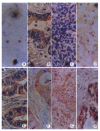Mycoplasma infections and different human carcinomas
- PMID: 11819772
- PMCID: PMC4723534
- DOI: 10.3748/wjg.v7.i2.266
Mycoplasma infections and different human carcinomas
Abstract
Aim: To explore relationships between human carcinomas and mycoplasma infection.
Methods: Monoclonal antibody PD4, which specifically recognizes a distinct protein from mycoplasma hyorhinis, was used to detect mycoplasma infection in different paraffin embedded carcinoma tissues with immunohistochemistry. PCR was applied to amplify the mycoplasma DNA from the positive samples for confirming immunohistochemistry.
Results: Fifty of 90 cases (56%) of gastric carcinoma were positive for mycoplasma hyorhinis. In other gastric diseases, the mycoplasma infection ratio was 28% (18/49) in chronic superficial gastritis, 30% (14/46) in gastric ulcer and 37% (18/49) in intestinal metaplasia. The difference is significant with gastric cancer (chi(2) = 12.06, P < 0.05). In colon carcinoma, the mycoplasma infection ratio was 55.1% (32/58),but it was 20.9% (10/49)in adenomarous polyp (chi(2)=13.46, P < 0.005). Gastric and colon cancers with high differentiation had a higher mycoplasma infection ratio than those with low differentiation (P < 0.05). Mycoplasma infection in esophageal cancer, lung cancer, breast cancer and glioma was 50.9% (27/53), 52.6% (31/59), 39.7% (25/63) and 41% (38/91), respectively. The mycoplasma DNA was successfully amplified with the DNA extracted from the cancer tissues that were positive for mycoplasma infection (detected with antibody PD4).
Conclusion: There was high correlation between mycoplasma infection and different cancers, which suggests the possibility of an association between the two. The mechanism involved in oncogenesis by mycoplasma remains unknown.
Figures


Similar articles
-
[Mycoplasma infection in human gastriointestinal carcinoma tissues].Zhonghua Yi Xue Za Zhi. 2001 May 25;81(10):601-4. Zhonghua Yi Xue Za Zhi. 2001. PMID: 11798932 Chinese.
-
[Detection of Mycoplasma hyorhinis in gastric cancer using bio-chip technology].Zhonghua Yi Xue Za Zhi. 2002 Jul 25;82(14):961-5. Zhonghua Yi Xue Za Zhi. 2002. PMID: 12181089 Chinese.
-
Mycoplasma hyorhinis infection in gastric carcinoma and its effects on the malignant phenotypes of gastric cancer cells.BMC Gastroenterol. 2010 Nov 10;10:132. doi: 10.1186/1471-230X-10-132. BMC Gastroenterol. 2010. PMID: 21062494 Free PMC article.
-
Does Mycoplasma sp. play role in small cell lung cancer?Lung Cancer. 2004 Jul;45(1):129-30. doi: 10.1016/j.lungcan.2004.01.007. Lung Cancer. 2004. PMID: 15196745 No abstract available.
-
DNA probes and PCR in diagnosis of mycoplasma infections.Mol Cell Probes. 1994 Dec;8(6):497-511. doi: 10.1006/mcpr.1994.1071. Mol Cell Probes. 1994. PMID: 7700272 Review.
Cited by
-
Bacterial Involvement in Progression and Metastasis of Adenocarcinoma of the Stomach.Cancers (Basel). 2022 Oct 6;14(19):4886. doi: 10.3390/cancers14194886. Cancers (Basel). 2022. PMID: 36230809 Free PMC article. Review.
-
Mycoplasma hyorhinis infection promotes TNF-α signaling and SMAC mimetic-mediated apoptosis in human prostate cancer.Heliyon. 2023 Oct 11;9(10):e20655. doi: 10.1016/j.heliyon.2023.e20655. eCollection 2023 Oct. Heliyon. 2023. PMID: 37867861 Free PMC article.
-
To Decipher the Mycoplasma hominis Proteins Targeting into the Endoplasmic Reticulum and Their Implications in Prostate Cancer Etiology Using Next-Generation Sequencing Data.Molecules. 2018 Apr 24;23(5):994. doi: 10.3390/molecules23050994. Molecules. 2018. PMID: 29695086 Free PMC article.
-
Computational approach for identifying immunogenic epitopes and optimizing peptide vaccine through in-silico cloning against Mycoplasma genitalium.Heliyon. 2024 Mar 28;10(7):e28223. doi: 10.1016/j.heliyon.2024.e28223. eCollection 2024 Apr 15. Heliyon. 2024. PMID: 38596014 Free PMC article.
-
Depletion of CG-Specific Methylation in Mycoplasma hyorhinis Genomic DNA after Host Cell Invasion.PLoS One. 2015 Nov 6;10(11):e0142529. doi: 10.1371/journal.pone.0142529. eCollection 2015. PLoS One. 2015. PMID: 26544880 Free PMC article.
References
-
- Lo SC, Hayes MM, Kotani H, Pierce PF, Wear DJ, Newton PB, Tully JG, Shih JW. Adhesion onto and invasion into mammalian cells by mycoplasma penetrans: a newly isolated mycoplasma from patients with AIDS. Mod Pathol. 1993;6:276–280. - PubMed
-
- Marshall AJ, Miles RJ, Richards L. The phagocytosis of mycoplasmas. J Med Microbiol. 1995;43:239–250. - PubMed
-
- Murphy WH, Bullis C, Dabich L, Heyn R, Zarafonetis CJ. Isolation of mycoplasma from leukemic and nonleukemic patients. J Natl Cancer Inst. 1970;45:243–251. - PubMed
-
- Cassell GH, Cole BC. Mycoplasmas as agents of human disease. N Engl J Med. 1981;304:80–89. - PubMed
-
- Taylor-Robinson D, McCormack WM. The genital mycoplasmas (first of two parts) N Engl J Med. 1980;302:1003–1010. - PubMed
Publication types
MeSH terms
Substances
LinkOut - more resources
Full Text Sources
Other Literature Sources

